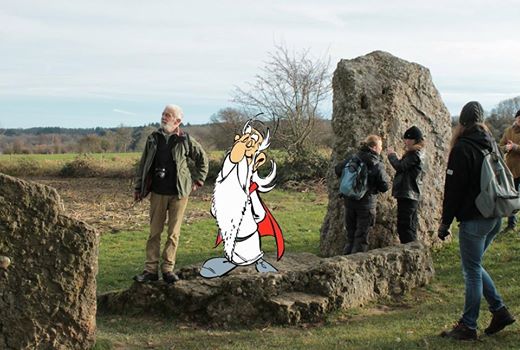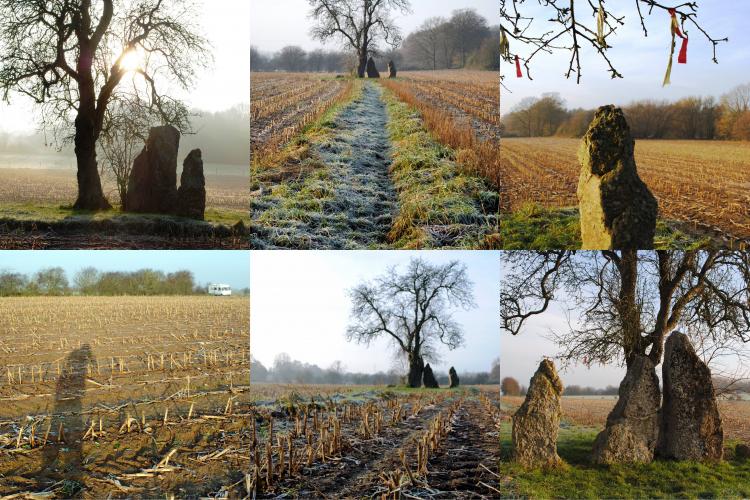
Wéris: menhirs and magical stories
Every year, again, we winter hike in Wéris. Upright stone guards from another world, herb remnants of last summer and yellow-green mistletoe lights cross our path. Not surprising that Wéris still appeals to the imagination.
These strange stones have always appealed to people. This is evidenced by the role played by the megalithic monuments in local folklore, the legends attached to it and the most strange traditions that surround them. For a long time, the work of giants, dwarfs, fairies, witches or the devil has been seen in it. Romantic authors from the 19th century stated that the hunebedden had been erected by our ancestors the Gauls. Druids would have used them as sacrificial tables. At the beginning of this century, the local poet Georges Lecompte writes that the dolmens were altars of the druids. This faith still holds. What's more, the megaliths are sometimes still the stage for magical-religious ceremonies reserved for initiates. In Stonehenge, for example, a druid ceremony took place every year during the summer solstitium and at dawn.
Druid
The druid Renaat de Jonghe, member of the “Cercle du Blanc Caillou” (White Kei-Circle), later the “Oeuf du Dragon” (Egg of the Dragon) tried to prove that the site of Wéris, once more important than that of Stonehenge and a megalithic highplace. Inspired by the Indian and Celtic cults, he defends the theory that the consecutive menhirs of Wéris would be part of the system capable of absorbing and spreading the energy of the Universe. At Pierre Haina, he conspires and prays for the sun, the earth, the water, the people and the animals. At the dolls of Wéris, he invites the public to entrust a piece of bread to Mother Earth to thank her for everything she gives us. In this way, traditional Celtic ceremonies are immortalized. Meanwhile, our druid has switched the temporal with the eternal.In Wéris there are several legends, fed by the presence of some peculiar natural rocks such as the “Pierre Haina” white menhir, the “Lit du Diable” and the “Pas Bayard”.
Pierre Haina or the Menhir Blanc (White Menhir)
The Pierre Haina, meaning “stone of the ancestors”, would, according to legend, cover a hole that would go to the center of the earth. Sometimes the devil emerges to perform his “devilish practices” and then rests on the Devil's Bed. A tradition also wanted the Pierre Haina to be whitened every year on the equinoculation of spring. The disused tradition was resumed by the Leuven professor, Ernest Pirson, who came to perform the rite every year. He did this until his death and claimed that according to the ancients the stone could be seen from Leuven. In 1975, the Ariane Group of the European Institute of Symbolism and History raised the tradition and the menhir was again whitewashed.Pas-Bayard stone (Step, Hoof of the Ros Carillon)
“In Pas-Bayard, a hamlet of the village of Oppagne, you will be shown on a stone a long and deep groove, which would be the trail of the hoof of the Ros Carillon, which turned away here in order to take the four Heemskinderen to Durbuy, at a distance of more than two miles.”Devil's Bedding
Once upon a time there was a miller who lived along the Aisne, and at a certain moment did not have enough water to feed his mill. Satan offered him to build a dike in one night in exchange for his soul. The cunning country dweller accepted, but didn't want to surrender his soul just like that. The next morning, when the work was finished, at the crowing of the cock, the devil called the miller to settle the bill, but only the miller's dog showed up. As soon as the devil understood that he had been deceived, he burst into anger and destroyed his night-time work in seconds. Exhausted, he came to regain strength on the stone that has since been called the Devil's Bed. The foundations of the diabolical dike are still found in the hamlet of Roche-à-Frène.Menhir, means “one”, stone and “hir”, long. Do these long, upright stones refer to a cemetery? Are they witnesses to an old solar ultus or were they just border poles? We'll probably never find out, and maybe that's a good thing!
#menhir #dolmen #Weris #herboristenopleiding #mauriceherborist
- Comments (0)
- Recommended
- Milestones
Here are your recommended items...
Here are your milestones...






